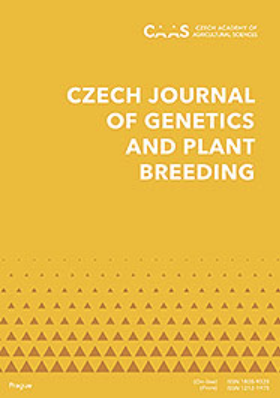基于形态和生化特性的伊朗石榴基因型数量比较
IF 1.8
4区 农林科学
Q3 AGRONOMY
引用次数: 2
摘要
石榴是已知最古老的可食用水果之一。从石榴籽、石榴汁和石榴皮中分离出了许多对人体健康有益的化合物。本研究旨在研究来自伊朗不同省份的24个石榴基因型的理化和形态特性。在伊朗亚兹德的伊朗石榴遗传收集中,每个品种的15个果实在石榴的正常成熟期收获成熟时收集。从树的四个方向上随机收获5个果实,并立即被带到实验室进行分析。每次分析维持3个重复。结果表明,花青素含量最高的品种是S783和R633,多酚含量最高的品种是Q529,抗氧化能力最高的品种是N755,总可溶性固形物含量最高的品种是K477和E336。另一方面,果实重量(S948)、果实直径(SH1738)、树冠直径(R533)、种子总重(S948)、果皮厚度(S716)、果皮颜色(S948)和红汁(S783)受基因型的显著影响。在相似度为50%的情况下,将基因型分为9个亚群,包括a、B、C、D、E、F、G、H和i。这些已确定的基因型可以在未来的育种计划中推广。本文章由计算机程序翻译,如有差异,请以英文原文为准。
Comparing the number of Iranian pomegranate genotypes based on morphological and biochemical properties
Punica granatum L. is one of the oldest known edible fruits. Numerous chemical compounds have been isolated from pomegranate seeds, juice, and peels, which have beneficial effects on human health. This study aimed to perform the physicochemical and morphological properties of twenty-four pomegranate genotypes from various provinces of Iran. Fifteen fruits of each cultivar are collected at harvest maturity in the normal ripening period for the pomegranate from the Iranian pomegranate genetic collection in Yazd, Iran. Five fruits were randomly harvested from each of four orientations of the tree, and were immediately taken to the laboratory for analysis. Three replicates were maintained for each analysis. The results indicated the highest levels of anthocyanin was observed in S783 and R633, while polyphenols in Q529, the antioxidant capacity in N755 and the total soluble solids levels in R633 and the total acidity levels were found in K477 and E336. On the other hand, the fruit weight (in S948), fruit diameter (in SH1738), crown diameter (in R533), total weight of the seeds (in S948), peel thickness (in S716), peel colour (in S948), and red juice (in S783) are significantly affected by the genotype. At a similarity of 50%, the genotypes were divided into nine sub-clusters including A, B, C, D, E, F, G, H and I. These identified genotypes can be rolled out in future breeding programmes.
求助全文
通过发布文献求助,成功后即可免费获取论文全文。
去求助
来源期刊

Czech Journal of Genetics and Plant Breeding
Agricultural and Biological Sciences-Plant Science
CiteScore
2.20
自引率
0.00%
发文量
25
审稿时长
>12 weeks
期刊介绍:
Original scientific papers, critical reviews articles and short communications from the field of theoretical and applied plant genetics, plant biotechnology and plant breeding. Papers are published in English.
 求助内容:
求助内容: 应助结果提醒方式:
应助结果提醒方式:


